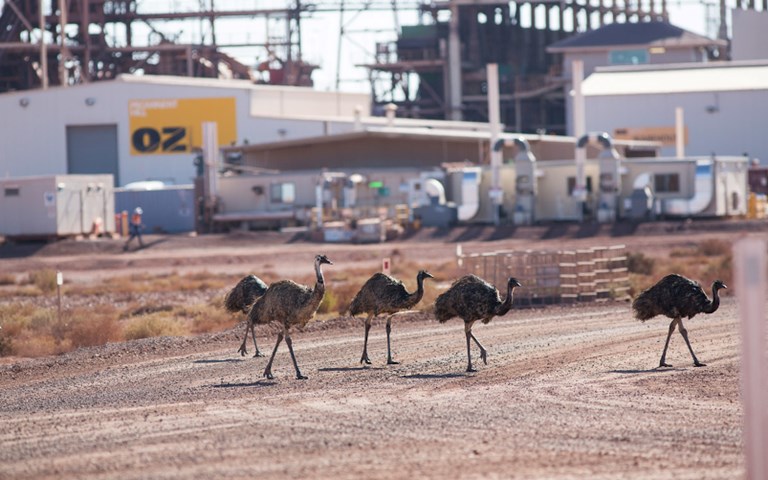The online exploration challenge focused on the Gawler region of South Australia where OZ Mineral’s Prominent Hill gold mine is located. Courtesy of OZ Minerals
Updated with additional information on PER-OZ's winning submission.
The winners have been announced for Unearthed Solutions’ Gawler Challenge in Australia, and the response it generated could provide a valuable lesson for the mining industry in Canada and abroad.
First announced on Mar. 2 at the PDAC Conference in Toronto, the Gawler Challenge was a contest open to geo- and data-science enthusiasts around the world to try and locate mineral deposits in the Gawler region of South Australia. Contestants used an open data set provided by the South Australian government, and the results of the finalists were published online for the free use of exploration companies working in the region.
“It’s the largest [challenge] that we’ve run to date. It had something like 2,200 participants from around the world,” Unearthed’s managing director Justin Strharsky said. “Great response in terms of innovators, and lots of interest from industry with people very curious to see what kind of techniques people can use and what kind of targets people are uncovering.”
Team PER-OZ – a collaboration between Paul Pearson from Latin Global and John McLellan from GMEX – took home first prize and A$100,000 for what Australian minister for energy and mining Dan van Holst Pellekaan called “their unique methodology, which could help geologists in the field find that needle in the haystack.” Their submission uses machine learning to test the relative importance of a large number of geological factors on known deposits, and uses a mineral systems approach that emphasizes and analyzes the passage of ore fluids and metals to deposition sites. The judging panel was impressed with the integration of mineral systems and geomechanics with machine learning techniques. Caldera Analytics, the winner of Unearthed’s 2019 Explorer Challenge, was the runner up.
For Strharsky, however, the impact that the challenge has had goes beyond just identifying mineral targets in the Gawler region. Instead, the potential for the kind of knowledge base generated by this challenge could be applicable worldwide.
“The kinds of things we’re paying attention to is how this will impact industry in general,” he said. “What should Canadian mining companies looking at this challenge think when they see [the results].”
The real value, according to Strharsky, is the creation of what he calls an “expert community,” a group of professionals and enthusiasts from around the world who are willing to apply their knowledge to solve difficult problems. In the case of the Gawler Challenge, data scientists and geoscientists collaborated to do “a year’s worth of work in a few months,” combing through the data and identifying potential targets for exploration. Being able to take advantage of a global knowledge base could be valuable in terms of lowering risk and making mining regions more attractive for investment.
Related: Textural characteristics of zircon minerals could be used to detect copper deposits, says a new Geoscience BC study
“We think that the contribution of all these participants in the Gawler Challenge means that the risk has been reduced for somebody investing in exploration in South Australia,” Strharsky said. “If we’re thinking about the flow of capital and resources exploration as kind of a global market, then we’re seeing the ante raised by South Australia in terms of attracting those investment dollars. It’s an open question as to what people are going to do to figure out how to attract the best investment dollars for projects in their jurisdictions, what are they going to do to make that beneficial for the people who live in those jurisdictions, and things like that.”
Following the announcement, the state government allocated an additional A$5 million from the Economic and Business Growth Fund to the Geological Survey of South Australia to further flesh out the top concepts from the competiton. Aside from running contests to promote exploration in specific regions, the global participation in the Gawler Challenge could be a sign of how companies could treat data analytics in the future. For Strharsky, crowdsourcing difficult data challenges could be a viable option for Canadian companies missing local talent.
“I think the talent pool that participated in this challenge was truly global, [with] more than 100 countries [participating.] This, as an example of the forces that are reshaping both threats and opportunities to industries, should really be paid attention to by any executive or board member of a mining company,” Strharsky said. “How is somebody in any mining province in Canada going to hire enough data scientists to do work on their data, to optimize the mill, to predict throughput, to optimize route planning of trucks…when there’s that much local scarcity in competition with tech companies and other big industrial companies for data scientists? But globally, there’s a proliferation of those skills because people are learning for free over the net.”
“The dynamic that we see is one of local scarcity in digital skills but global abundance,” he continued. “So, mining companies – just like any other companies in any other industry facing the same thing – the ones that are going to be successful in the future are going to figure out how to shift the way that they work to take advantage of the global abundance of digital skills.”



